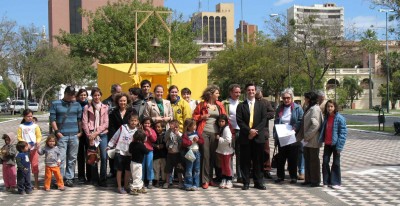

 | ||||
|
This is an example of a monologic classroom. There is no dialogue - even when the teacher asks a question, he doesn't expect an answer, and answers it himself. | ||||
 |
 |
 |
|||
| Polyphony in the Classroom [On Dostoevsky crafting a polyphonic text:] The entire work would have been constructed by him as a great dialogue, but one where the author acts as organizer and participant in the dialogue without retaining for himself the final word; that is, he would have reflected in his work in the dialogic nature of human life and human thought itself. (Bakhtin, 1963/1984, p. 96) |
||||
 | ||||
|
This description of how the author crafts a dialogic narrative is very similar to the way a teacher or researcher might engage in a dialogic classroom. In this excerpt from Ayers and Alexander-Tanner's (2010) To Teach: The Journey, In Comics, the direction of the activity is not planned by the teacher, but received form the students, and each statement the teacher makes is dialogic, expecting a response from the student. The teacher doesn't have the final word, and acts as an organizer and participant, but not a leader. |
||||
 |
 |
 | |||
| The Carnivalesque Classroom All these forms are systematically placed outside the Church and religiosity. They belong to an entirely different sphere. Because of their obvious sensuous character and their strong element of play, carnival images closely resemble certain artistic forms, namely the spectacle. In turn, medieval spectacles often tended toward carnival folk culture, the culture of the marketplace, and to a certain extent became one of its components. (Bakhtin, 1965/1984, p. 197) In fact, carnival does not know footlights, in the sense that it does not acknowledge any distinction between actors and spectators. Footlights would destroy a carnival, as the absence of footlights would destroy a theatrical performance. Carnival is not a spectacle seen by the people; they live in it, and everyone participates because its very idea embraces all the people. (p. 198) | ||||
 |
||||
| This is a similarly relevant theoretical basis for classroom practice, especially in the arts classroom. Carnivalesque spaces, with their free and uncensored expression, lend themselves to artistic expression. The Carnival is inherently participatory, and the fact that it elminates borders and heirarchical roles makes it a model for a creative classroom. The dialogic classroom illustrated above by Ayers and Alexander-Tanner is a carnivalesque space. |
||||
 |
 |
 | |||
|
Dialogue with the Voices of the Community through Art Reflecting upon dialogism and dialogic encounters in relation to dialogue and voice as these pertain to pedagogy, I propose that an education based on prepackaged curriculum and instruction is answerable only to itself, specifically, because one-way conversation does not respond to a multiplicity of voices and subjectivities, which are vital to dialogic relationships. (Miles, 2010, p.378)  The School of Panamerican Unrest was an extensive public art project that involved an intercontinental road trip along the length of the Pan-American Highway. At each stop, which included traditional and non-traditional art venues, [Pablo] Helguera conducted artist workshops, round-table discussions, and performances. The topics and ideas for each site unfolded in relationship to the specificity of each location (including such factors as socio-political history and culture) and in collaboration with the interests and visions of local organizers, artists, and participants. (p. 376) |
||||
 |
||||
| So dialogue, particularly Bakhtin's focus on incorporating diverse voices, and on the primacy of folk culture could be a theoretical basis for introducing students to community-based artwork, or to planning and executing community-based artwork with students. Unfinalizability and Artmaking Bakhtin's notion of unfinalizability can lead students to think critically about when a work (their work, or any work) is complete. This can be a basis for reflection on their practice, or for reaction to observed work. Albrecht Schenck thought this painting was finished:  Dali did not:  |
||||
 |

Ayers, W., & Alexander-Tanner, R. (2010). To teach: The journey, in comics. New York, NY: Teachers College Press.
Bakhtin, M. M. (1981). Discourse in the novel (C. Emerson & M. Holquist, Trans.). In M. Holquist (Ed.), The dialogic imagination: Four essays by Mikhail Bakhtin (pp. 259-422). Austin, TX: University of Texas Press. (Original work published 1975).
Bakhtin, M. M. (1981). Epic and Novel (C. Emerson & M. Holquist, Trans.). In M. Holquist (Ed.), The dialogic imagination: Four essays by Mikhail Bakhtin (pp. 3-40). Austin, TX: University of Texas Press. (Original work published 1941).
Bakhtin, M. M. (1981). Forms of time and of the chronotope in the novel (C. Emerson & M. Holquist, Trans.). In M. Holquist (Ed.), The dialogic imagination: Four essays by Mikhail Bakhtin (pp. 84-258). Austin, TX: University of Texas Press. (Original work published 1937).
Bakhtin, M. M. (1984). From Rabelais and his world (H. lswolsky, Trans.). In P. Morris (Ed.), The Bakhtin reader (pp. 195-244). New York, NY: Oxford University Press. (Original work published 1965).
Bakhtin, M. M. (1984). Problems of dostoevsky's poetics. (C. Emerson, Trans.). Minneapolis, MN: University of Minnesota Press. (Original work published in 1963).
Bakhtin, M. M. (1986). From speech genres and other late essays (H. lswolsky, Trans.). In P. Morris (Ed.), The Bakhtin reader (pp. 81-87). New York, NY: Oxford University Press. (Original work published 1976).
Cuenca, A. (2010). Democratic means for democratic ends: The possibilities of Bakhtin's dialogic pedagogy for social studies. The Social Studies, 102(1), 42-48.
Dimitriadis, G., & Kamberelis, G. (2006). Theory for education. New York, NY: Routledge.
Miles, A. P. (2010). Dialogic encounters as art education. Studies in art education: A journal of issues and research 51(4), 375-379.
Roberts, G. (1994). A glossary of key terms. In P. Morris (Ed.), The Bakhtin reader (pp. 245-252). New York, NY: Oxford University Press.
Rule, P. (2011). Bakhtin and Freire: Dialogue, dialectic and boundary learning. Educational philosophy and theory 43(9), 924-942.